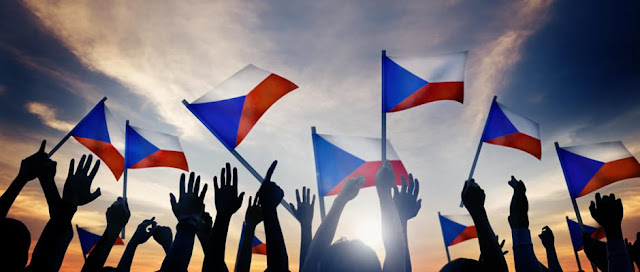On the Cusp of a Century
 |
| Photo source here. |
Notable years in recent Czech history often end in an "8."
- Czechoslovakia was founded toward the end of World War I on 28 October 1918.
- The Munich Agreement — in which the allies threw Czechoslovakia under the bus and gave Germans control of the borderlands (effectively crippling the country's defenses) in the hope of placating Hitler and avoiding war — happened in the fall of 1938. (Also? Did not placate Hitler.)
- In 1948 Prime Minister Klement Gottwald (who was also the head of the Communist party) staged a coup which ushered in the era of communism.
- Prague Spring, the period of political liberalization, started in early 1968 when President Alexander Dubček loosened controls on media, speech, and travel. It was snuffed out when the Warsaw Pact tanks rolled into town on 21 August.
Some folks include the Velvet Revolution, which took place in November 1989, in this list, saying the roots of the period that led in earnest to the resignation of the Communists began in 1988. But that's a bit of a stretch.
So in 2018 there are several anniversaries that end in a "0." The majority of them dredge up unhappy memories, but all of them helped shape the psyche of Czechs today. All of the dates are being honored this year, but the big whistles-and-bells focus is on the lead up to the centennial anniversary of breaking out from under Habsburg rule. Makes me sad we won't be here next October.
Additionally, 1 January 1993 was the day that the Czech Republic and Slovakia officially became two separate nation states (the so-called Velvet Divorce). As such, 2018 also marks the 25th anniversary of the Czech Republic. (That's right — it's been 25 years since Czechoslovakia existed. You'll still find plenty of foreigners, however, who can't quite make the split when talking about the region! But, I digress.)
On the last day of 2017, we took a walk up Petřín hill to appreciate the view of the city and climb the Eiffelovka, the lookout tower atop the hill. It seemed an appropriate way to spend New Year's Eve afternoon.
 |
| St. Vitus Cathedral rising up from inside the castle complex. |
 |
| St. Nicholas in Malá Strana |
 |
| The National Theatre |
 |
| Spires of St. Lawrence Church |
 |
| From the Eiffelovka, looking toward Old Town |
 |
| Charles Bridge, chock-full of revelers gearing up for a big night. |
 |
| From the Eiffelovka |
 |
| Toward Letná park. Can even (just) make out St. Anthony's in Strossmayer Square, our neighborhood. (Click on the picture for a bigger image, if you wish.) |
It was a gorgeous day.
That ended with a glorious, jump-off-the-tram-to-snap-a-shot sunset.
 |
| Farewell to 2017 |
At midnight on New Year's Eve the amateur-hour fireworks shows began all over the city and the countryside. We watched from the safety of our flat. It went full on for at least one hour, with rogue blasts occurring until almost 2am.
At 6pm on New Year's Day, the official city fireworks were presented from Letná park, a special celebration of this auspicious centennial year, with the theme "One Hundred Years in the Capital City of Prague." If you are interested in seeing a pyrotechnic-interpretation of history and have 11 minutes to spare, it really is a beautiful display with voice-over quotes from first Czechoslovak President Tomáš Masaryk and playwright/dissident President Václav Havel and music that recalls specific decades and evokes everything from foreboding to joy.
The first two minutes of the video show the team prepping and setting up the display on New Year's. I recommend that you maximize the screen to get the full details.
The first two minutes of the video show the team prepping and setting up the display on New Year's. I recommend that you maximize the screen to get the full details.
The program roughly addresses five periods ~
- První republika (The First Czechoslovak Republic, 1918) — The end of WWI and the birth of the new independent state Czechoslovakia.
- Pražské povstání (Prague uprising, May 1945) — An attempt by the Czech resistance to liberate the city of Prague from German occupation during WWII.
- Pražské jaro 1968 (Prague Spring, 1968) - Occupation of Czechoslovakia by the Soviet Union.
- Sametová revoluce (Velvet Revolution, November 1989) - end of communism. Celebration of democratic state.
- Sametová rozvod (Velvet Divorce, 1993) - Czechoslovakia splitting into two independent nation-states: the Czech Republic and Slovakia.
It was a surprisingly emotional piece to behold, in part because the segment with the two nuclear bombs was truly terrifying and seemed almost to be an accident from my vantage point, as if they'd misfired and set Letná park ablaze! But all of it — including the swelling strains of Beethoven's "Ode to Joy" (which the European Union adopted as its anthem) and the Czech national anthem, and the heart to represent Havel — made for the most memorable and moving fireworks display I've ever seen.





Gorgeous photos. You are making the most of that camera! And you made it to the end of 2017 before my visit!
ReplyDelete